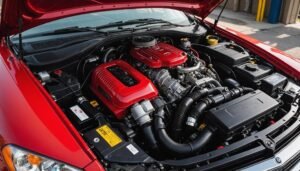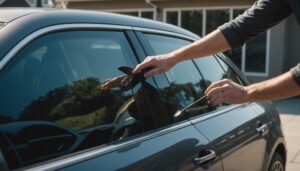If you’re considering giving your car a fresh look, understanding the costs involved is essential. Factors like vehicle size, paint type, and existing paint condition all play a role in determining the final price. Whether you opt for a DIY approach or hire a professional can greatly impact your budget. The average costs vary widely, but knowing these nuances will help you make informed decisions. What specific aspects should you be aware of as you explore your options?
Key Takeaways
- The average cost to paint a compact car ranges from $300 to $600, with larger vehicles costing more.
- Professional services ensure high-quality results but can be more expensive due to labor costs and expertise.
- Types of paint vary in price: acrylic lacquer ($25-$50), enamel ($35-$70), and urethane ($70-$150) per gallon.
- DIY painting can save money but requires significant prep work and skill to avoid mistakes.
- Custom designs and extensive prep work will increase the overall cost of the painting project.
Factors Influencing the Cost of Painting a Car

When considering the cost of painting a car, several key factors come into play. First, the type of paint you choose can markedly impact your expenses. High-quality paints may cost more initially but might provide better durability and finish. Second, the size of your vehicle affects the amount of paint needed, so larger cars typically incur higher costs.
Next, the condition of the car’s current paint job is vital; if it requires extensive prep work, like sanding or rust repair, you’ll need to factor that into your budget. Labor costs also vary widely depending on the shop’s location and expertise. Finally, any intricate designs or additional protective coatings can add to the overall price. All these elements work together to help you estimate what you’ll ultimately spend. By understanding these factors, you can better prepare for your car painting project.
DIY vs. Professional Painting: Weighing Your Options

Are you contemplating whether to tackle a car painting project yourself or hire a professional? This decision hinges on several factors, including your budget, skill level, and desired outcome. DIY painting can save you money and give you the satisfaction of a personal touch. However, this route requires significant prep work, proper equipment, and a keen eye for detail. If you’re inexperienced, you might end up with uneven surfaces or paint runs.
On the other hand, hiring a professional guarantees high-quality results with less risk of mistakes. Professionals have the necessary tools and experience to deliver a flawless finish. While this option typically costs more, it can save you time and frustration.
Ultimately, weigh the pros and cons: do you have the time and skills for a DIY job, or would you prefer to invest in professional expertise for a stunning, durable paint job? Choose what aligns best with your vision.
Types of Paint and Their Price Ranges

Choosing the right type of paint for your car paint job is essential, as it can markedly impact both the appearance and durability of the finish. Automotive paints typically fall into three main categories: acrylic lacquer, enamel, and urethane.
Acrylic lacquer is the least expensive, usually ranging from $25 to $50 per gallon, but it offers less durability and protection. Enamel paint, costing about $35 to $70 per gallon, provides more longevity and a better finish but can take longer to dry. Urethane paint is the most premium option, priced between $70 and $150 per gallon. It boasts excellent durability, UV resistance, and a smooth finish.
You’ll also want to factor in the cost of primers and clear coats, which can add $20 to $60 each. By choosing the right paint type, you guarantee your vehicle looks great while standing up to the elements.
Additional Costs You Might Encounter
While you might focus primarily on the cost of paint, there are several additional expenses that can arise during the car painting process. One of the most significant costs is preparation. This includes sanding, priming, and repairing any dents or rust, which can add up quickly. Don’t forget about labor costs if you’re hiring professionals; skilled painters often charge by the hour.
Additionally, you’ll want to take into account the cost of protective coatings or sealants to guarantee your new paint job lasts longer. If your vehicle has any customwork, like decals or patterns, that could further inflate your budget.
Finally, if your paint job requires special equipment or materials—like a spray booth or high-quality brushes—those costs can also add to your overall expenditure. Being aware of these potential expenses will help you plan a more accurate budget for your car painting project.
Average Cost Breakdown by Vehicle Size
When considering how much to paint your car, vehicle size plays a significant role in determining the overall cost. Smaller cars typically cost less to paint, while larger vehicles will demand higher fees due to the increased materials and labor required. Here’s a breakdown of average costs by vehicle size:
| Vehicle Size | Average Cost |
|---|---|
| Compact Car | $300 – $600 |
| Midsize Car | $500 – $900 |
| SUV | $600 – $1,200 |
| Pickup | $700 – $1,500 |
| Van | $750 – $1,600 |
Understanding these averages can help you budget effectively. Remember, the condition of your vehicle and the quality of paint also affect final prices. By knowing what to expect, you can make a more informed decision when moving forward with your car’s paint job.
Tips for Saving Money on Car Painting
Finding ways to save money on your car painting project can make a considerable difference in your overall costs, especially after reviewing the average prices based on vehicle size. Here are some tips to help you cut expenses:
Discovering cost-saving strategies for your car painting can significantly impact your budget and final expenditure.
- DIY Preparation: Spend time sanding and cleaning the surface yourself. This minimal prep work can considerably reduce labor costs when you take it to a shop.
- Choose the Right Paint: Investing in mid-range paint can balance quality and cost. While high-end options look great, you don’t always need the most expensive product for a solid finish.
- Off-Peak Scheduling: Book your appointment during slower seasons. Many shops offer discounts in winter or weekdays, which can lead to noticeable savings.
Frequently Asked Questions
How Long Does a Typical Car Paint Job Last?
A typical car paint job lasts around five to seven years, depending on various factors. You’ll want to evaluate the paint quality, climate conditions, and how well you maintain the vehicle. Regular washing and waxing can greatly extend the life of the paint. If you park indoors or use a protective cover, you can also enhance durability. Ultimately, taking care of your car’s exterior makes a big difference in longevity.
Can I Change the Color of My Car?
Absolutely, you can change the color of your car! Picture transforming your vehicle from a mundane gray to a vibrant red, catching the sun’s rays and turning heads. To achieve this, you’ll need to choose high-quality paint and surface preparation. A professional touch guarantees an even finish. Remember, different colors may require varied techniques, and it’s essential to check your local regulations regarding color changes. Your car’s new hue can truly redefine its personality!
What Preparation Is Needed Before Painting?
Before painting, you’ll need to clean the surface thoroughly to remove dirt, grease, and old wax. Next, inspect for rust or damage, and sand these areas to create a smooth base. Use masking tape to cover areas you don’t want to paint. Primer is essential; it helps the paint adhere properly. Finally, make sure you’re in a well-ventilated area and consider using drop cloths to protect the surrounding surfaces.
Does Weather Affect the Painting Process?
Absolutely, weather can dramatically affect the painting process! Imagine trying to paint your car during a monsoon—definitely a recipe for disaster! High humidity can lead to poor adhesion, while cold temperatures can slow down drying. Ideally, you want a dry, warm day with low humidity. If you paint in harsh conditions, you might end up with a finish that’s less than perfect. Keep an eye on the forecast to guarantee success!
Will a Paint Job Increase My Car’s Resale Value?
Yes, a fresh paint job can notably boost your car’s resale value. When you maintain your vehicle’s appearance, it attracts potential buyers and reflects upkeep, which can lead to higher offers. A well-executed finish also helps cover imperfections and rust, enhancing overall aesthetics. However, keep in mind that the quality of the paint, color choice, and current market trends play essential roles in determining just how much value it adds.













